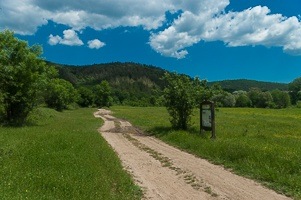
Kosti village and the 14 brothers oaks in Strandzha
The village of Kosti into Strandzha Nature Park is popular with its nestinarian customs, the old-growth forests and eco-trails in its surroundings. It is a suitable destination both as a for rural tourism and adventure tourism. Attractive is also the preserved old houses, as well as its church, which is one of the most beautiful rural churches in the area. Moreover, its proximity to the Black Sea resort of Tsarevo (24 km away) makes it an accessible tourist destination for holidaymakers that want to diversify their seaside vacation. The village also offers guest houses for a more extended stay.
Here we will present an easy and short hiking trail leading to the chapel “St. Elijah ‘and the 300-year-old 14 old Strandzha oaks. As rural tourism landmarks, along this walk can see lovely nature and a chapel, essential for the culture of local people. That species of wood is called Strandzha oak (Quercus hartwissiana), and in Strandzha they call them “Lazhnik.”
Below you will find brief information about the village of Kosti and pictures of old wooden houses and the church.
How to get to St. Elijah and the 14 brother oaks from the village of Kosti – map, route and GPX file Download file: Kosti-14-oaks-EN.gpx GPX file
USEFUL: For more information on how to open GPX files with a smartphone, see this link .
For planning your visit to the place or accommodation in the nearby settlements, can use the collection of assistive tools – Google Road Map with calculator in km, flights to Bulgaria, rental cars, weather forecast, hotel search, timetables of buses in the region, see this link.
The length of the trail is 2 km and takes about 30 minutes in one direction. Indeed, it is easy and suitable for all age groups. Besides, the road is in excellent condition – full and covered with gravel, and there is no section, where it is necessary to walk in high grass.

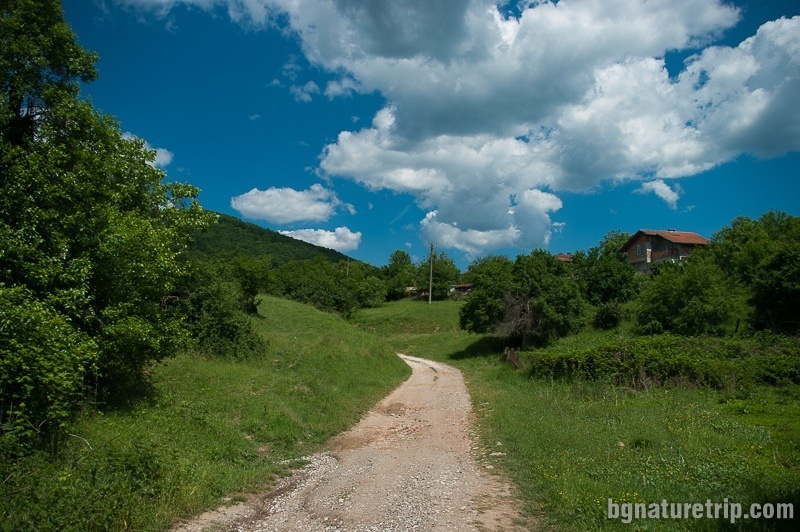
Plants along the trail
At the very beginning, we passed something similar to a canyon, on whose walls we saw a Pink rock-rose (Cistus incantus)
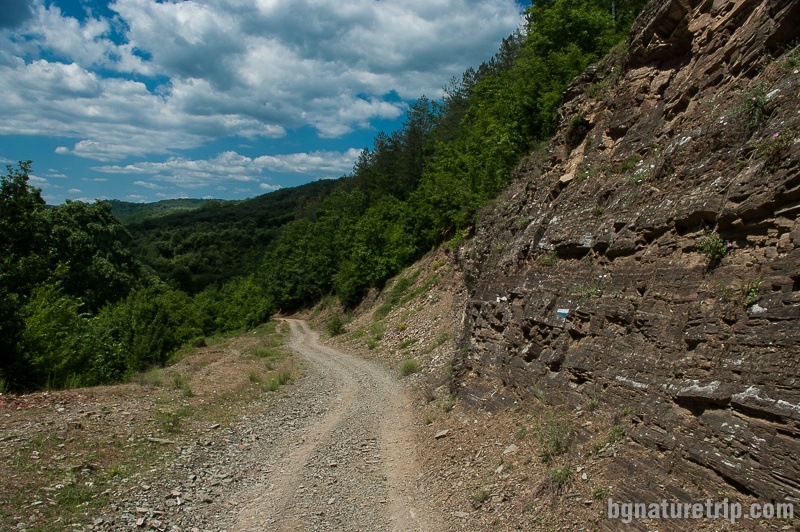


In this charming spring walk, we came across also other beautiful plants whose photos we share here:


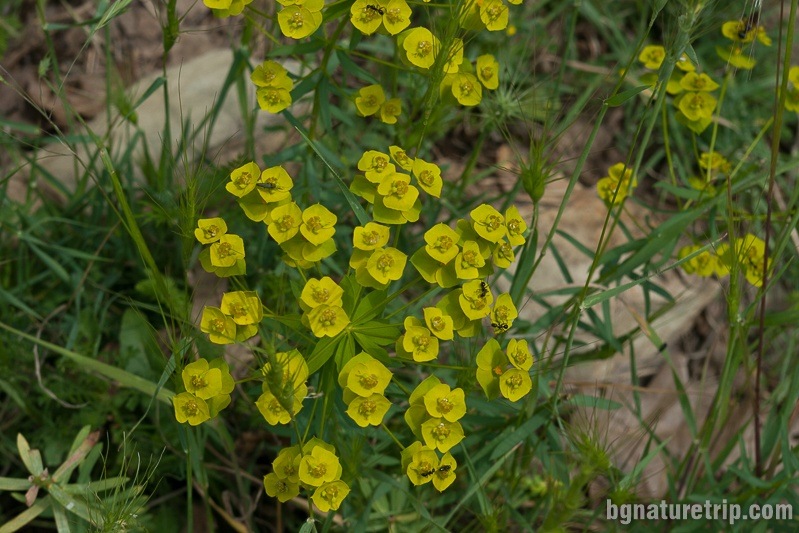
There is milky juice in its stem and is used in folk medicine or as an ornamental plant. Its habitat is dry, rocky places, but sometimes it also enters the infields. Farmers consider it a weed and fight it.
The Strandzha oaks
The trail is close to the Veleka River, and the old oaks are the remnants of its coastal forest. As can be read from the information boards, some of the trees have housed “Hajduk” inscriptions under their bark since the mid-19th century. In those troubled times of Ottoman slavery “Hajduks” were fighters for freedom of Bulgaria.
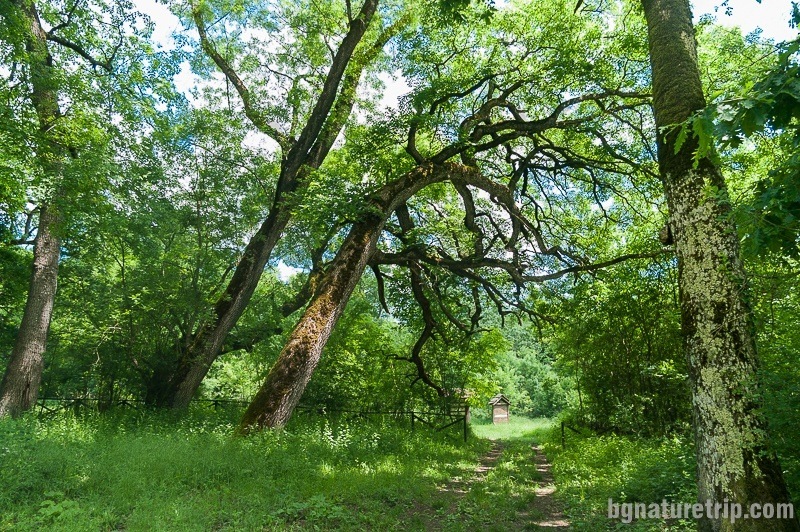
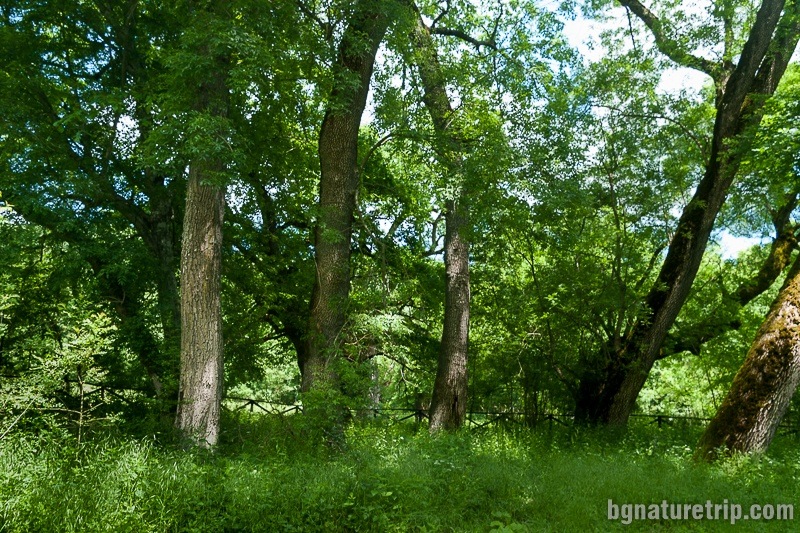

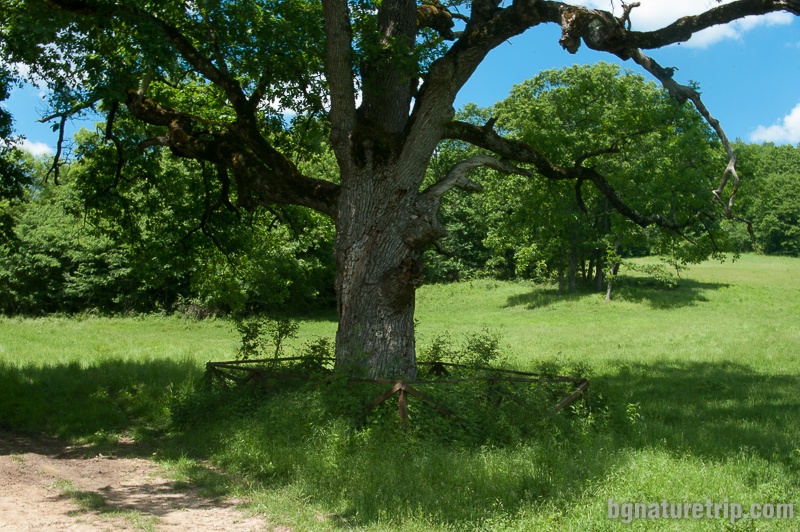
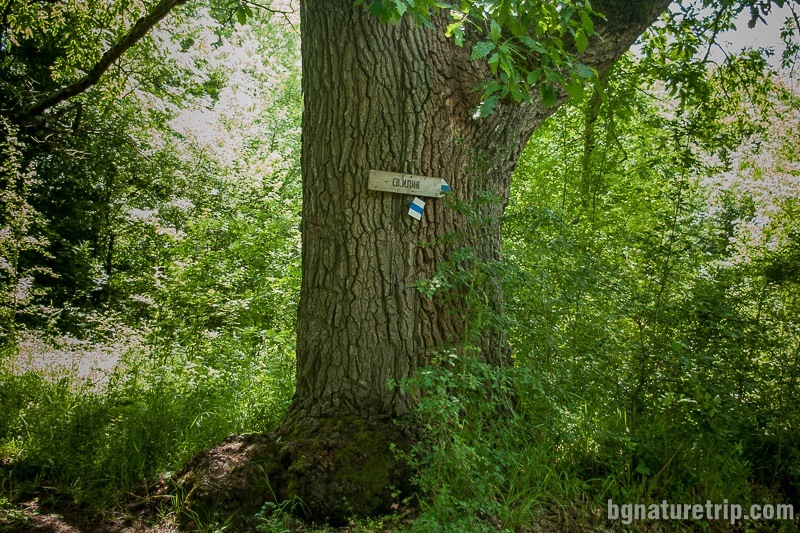
Preservation of nature
The entire area where is the eco-trail lays into the territory of Strandzha Nature Park and the European ecological network Natura 2000. Also, it has a forest status. Therefore some rules should be observed when visiting to protect natural resources.
To put it briefly – do not throw away waste, do not tear plants, do not light a fire, no camping, and let the place look like you’ve found it!
For more details, or if you intend to carry out particular activities other than a tourist walk, the full text of the laws can read here.
- Strandzha Nature Park – current prohibitions and regimes ( the page of Bulgarian “Executive Environment Agency”)
- Bulgarian Forestry Act
Chapel of St. Elijah
There is a chapel near the oaks and a picnic shelter. Its builders didn’t choose its name arbitrarily – St. Elijah is the patron of the Kosti village.
In Strandzha folklore St. Elijah is a fiery saint and moves in the heavens with a fiery chariot erupting thunders. In fact, he is considered as the Christian heir to the ancient solar cult. So that to emphasizes the connection with the sky and the sun, its chapels are always in open places or hills.
Inside the chapel, on the floor, there is a spring with healing water which is supposed to be curing for skin diseases, according to local people. As a matter of fact, we have not personally tried it to share our impressions.
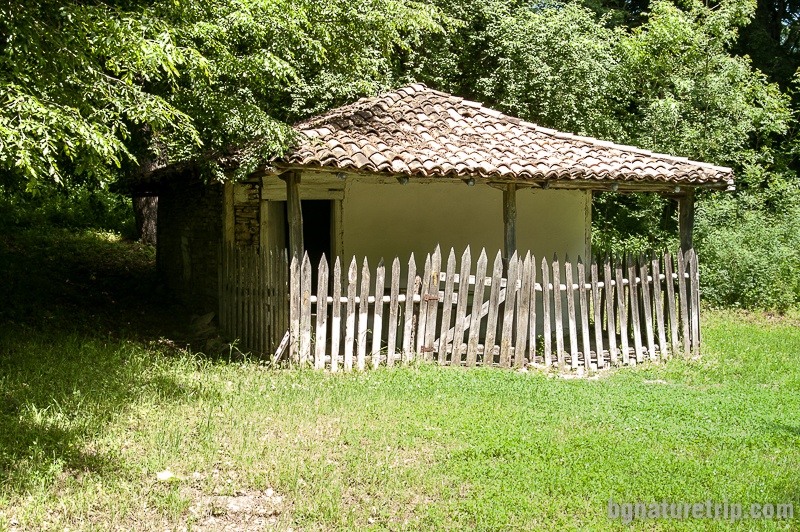
The chapels in Strandzha
There are several other chapels in the vicinity of Kosti village – St. Our Lady, St. Marina, St. Petka, and St. Constantine. That is typical for the whole of Strandzha mountain – each village is surrounded by many chapels (the locals call them monasteries). According to old folklore beliefs – this way, the settlement becomes a sacred territory, and contagious diseases cannot enter. Indeed, many of the chapels were built after a dream or a prophecy. Usually, the saint who had appeared in it and had given instructions for the place where the new church has to be built became the patron saint of the newly built temple.
In the other villages of Strandzha, the chapels are also sights of rural tourism.
The chapel – home of St. Elijah, the patron saint of the village of Kosti
Photo gallery of old wooden houses in the Kosti village, representatives of Strandzha architecture:
Here we present the old wooden houses we were able to find in Kosti. Before around a hundred years, Greeks lived here, and their homes have preserved. A characteristic feature of some of them is that they were two-storeyed with a spacious 2nd floor but with no windows. The lighting was provided through a roof window called the “movable tile”. In our visit to Kosti at the present time, we were able to find only one house of that kind, but in deplorable condition – number 9 in our gallery. Number 10 originally belonged to the Greek merchant Dundov, and then, because of its excellent location – in the centre next to the church, it was used by the Forestry and the Village Council. Unfortunately – it is currently burned out.
Number 5 is much more recent – built in the 1940s and as can be seen – quite different from the representatives of typical Strandzha architecture.
[supsystic-gallery id=’8′]
Rural tourism in Kosti – guesthouses as accommodation offer
Booking.com
Choosing Kosti as a destination for rural tourism, tourists can come to appreciate the traditional Strandzha lifestyle and folk traditions, as well as seeing the old Strandzha architecture.
Historical notes on the Kosti village
According to a local legend, the name of the Kosti comes from its first settler – the wealthy Greek Kostaki. He began to uproot the trees along the banks of the Veleka River, thus taking over its fertile soils. He cultivated corn, sunflower and hemp and traded with the surrounding Strandzha villages. The village was initially called Kostaki and later transformed into Kosti and settled with Greeks.
There is no indication of exactly when this happened, but probably the legend may be incorrect, or just Kostaki wasn’t engaged in planting corn. Kosti village was mentioned in an Ottoman tax document of 1498, and as we all know, the corn, whose homeland is America, was just seen for first by the colonizers at that time. The plant came to Europe at least 50 years later, when the first settler of Kosti, whoever he is, undoubtedly, already had not been alive.
Origin of the name
There is another thesis about the origin of the name, which seems much more likely. “Kosti” comes from the name of St. Constantine. The Feast of St. St. Constantine and Helena is of particular respect here – it is preceded by Nestinarian ( on the fire )dances and ceremonies, organizing a whole procession and going to the holy place – the Great Ayazma. The large church on the square erected by the local Greeks also has the name “St. St. Constantine and Helena”. As mentioned above, there is also a chapel in the vicinity of the village, whose patron is St. Constantine.
In the seventeenth century, Kosti was present in the tax register of Anhialo (Pomorie). The document also included the surrounding area of Agatopol (Ahtopol), to which Kosti is directly subordinate.
During the Russo-Turkish War of 1828-1829, the village was mentioned for the first time as “Greek”.
After the Liberation
It had remained greek until the Balkan War of 1912-1913 when the Greeks migrated to Greece. There they also transferred the Nestinarian rituals, which are still performed today in two Thessaloniki villages. After the Inter-Allied War ( Second Balkan War) in 1913, Bulgarians from Eastern Thrace began to settle in the Kosti (similar to many other towns along the South Black Sea Coast).
Customs
Every last Sunday of May, preceding the feast of St. St. Constantine and Helena” (June 3) from Kosti village starts the Nestinar procession. It visits one of the most sacred places for Strandzha mountain – the Great Ayazma in “Vlachov Dol” area. Nestinar dancers from the other Nestinar villages – Balgari, Kondolovo, Gramatikovo and Slivarovo – gather there. Since 2005, the visiting Greek Nestinar dancers, descendants of the Greeks who lived in the village in the past, annually have joined the procession of Kosti.
The Kosti village fest is on August 2 – the feast of “St. Elijah.” In case August 2 is a weekday, the celebration is postponed to Saturday or Sunday. Then a fair takes place here, and in the evening there are Nestinar dances.
The church “St. St. Cyril and Methodius’ Square in the village of Kosti – one of the largest village churches in Strandzha
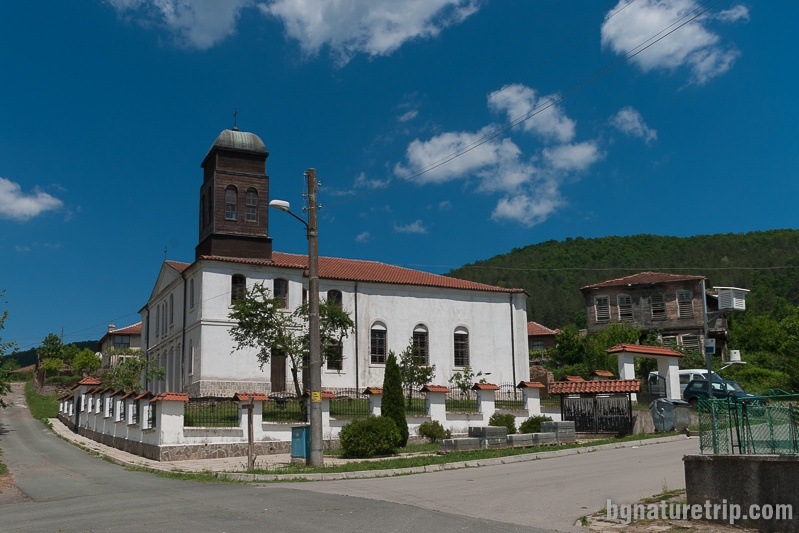
Transport to Kosti village
There is also a bus to the village of Kosti, that departs in the early morning and afternoon from Tsarevo city, for more information you can see this link – http://avtogaratsarevo.eu/
What else can see near Kosti village
- Another opportunity for a nice walk is to go along the adventure eco-trail leading to “Bogorodishki Dol” where there is a small waterfall “Kazancheto”. Besides, this walk allows seeing the rare Strandzha plant and symbol of Strandzha mountain – Rhododendron ponticum
- The second option is the “Raikov Vir” waterfall. There you can also see the Rhododendron ponticum
- A third opportunity is to visit “Diado Valcho” Peak and Protected area “Briar root” near the Silkosia Reserve.
In conclusion, we can say that the hospitability of local people and the lovely nature in the area all, inevitably, make rural tourism in Kosti memorable and provokes a desire for returning.
Continue the trip
In case you drive in the west direction to Malko Tarnovo, you can pop in the villages of Balgari, Kondolovo and Gramatikovo as other opportunities for rural tourism and more eco-trails, nature and historical landmarks.
In case you drive in the east, towards the Black Sea, you can visit the area “Marina Reka” for one more hiking through dense forest with rare plants. After that can continue to the Black Sea resorts Tsarevo, Varvara, Ahtopol or Primorsko (north) for other landmarks, beaches and lovely seascapes.
USEFUL: To get a quick and easy idea of where these places are – see the destinations marked on our Google map. There all the landmarks we’ve written about, are marked as tags with links.
Also, to plan your trip to them, you can use the selection of assistive tools: Google Road Map with calculator in km, flights to Bulgaria, rental cars, weather forecast, hotel search, timetables of buses in the region.
Offers for hotels nearby in Tsarevo city
Booking.com